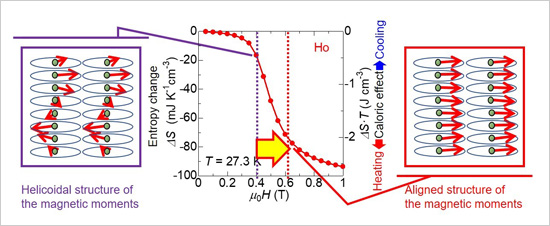High Efficiency Magnetic Cooling by Using Small Magnetic Field Changes
—Phenomenon May Be Applicable to the Development of Compact, Permanent Magnet-Based Systems Enabling Energy-Efficient Liquid Hydrogen Storage and Transportation—
2021.02.19
National Institute for Materials Science (NIMS)
Japan Science and Technology Agency (JST)
NIMS has discovered that holmium metal, which exhibits a metamagnetic transition, can induce a large cooling effect when only small magnetic field changes are applied to it using permanent magnets.
Abstract
- NIMS has discovered that holmium metal, which exhibits a metamagnetic transition, can induce a large cooling effect when only small magnetic field changes are applied to it using permanent magnets. The magnetocaloric efficiency generated by this material was one order of magnitude larger than that generated by conventional magnetocaloric materials. These results may be applicable to the development of a new magnetic refrigeration technology capable of efficiently cooling hydrogen at cryogenic temperatures using permanent magnets.
- Putting clean hydrogen energy into widespread use is one of Japan’s strategies for achieving carbon neutrality. Popularizing the use of hydrogen fuel will require the development of technologies enabling storage and transportation of liquid hydrogen, which is much denser than gaseous hydrogen. A cooling technology that can keep hydrogen at its liquefaction temperature of -253°C is particularly important. The cooling efficiency of conventional gas compression-expansion cycle systems diminishes with decreasing system size. Magnetic refrigeration is potentially a more efficient cooling technology than conventional gas compression refrigeration. This technology uses the magnetocaloric effect: heat is absorbed by a magnetic material when the orientation of its magnetic moments changes from uniform to irregular, increasing its magnetic entropy. Although the theoretical cooling efficiency of magnetic refrigeration is higher than that of gas compression refrigeration, it requires the generation of a strong magnetic field using a superconducting magnet to align the orientations of the magnetic moments in the magnetic material. This powerful magnetic refrigeration technology is expected to be suitable for medium- to large-scale hydrogen liquefaction (i.e., production of more than 100 kg of liquid hydrogen per day). Small-scale magnetic refrigeration is also an essential technology for the transportation of liquid hydrogen in trailers and other vehicles while minimizing hydrogen vaporization. Active efforts have been made to develop compact magnetic refrigeration technologies that employ permanent magnets.
- NIMS has recently focused on metamagnetic transition: a dramatic change in the orientation of magnetic moments in a magnetic material with a small change in an externally applied magnetic field. In this research project, NIMS observed changes in magnetic entropy in holmium metal, which was known to exhibit metamagnetic transition when a weak magnetic field is applied to it using a permanent magnet. As a result, holmium metal was found to be able to induce a magnetocaloric efficiency one order of magnitude larger than that induced by conventional magnetocaloric materials when only a small magnetic field change is applied to it. NIMS also found that the metamagnetic transition in holmium metal occurs across a wide temperature range above hydrogen’s approximate boiling point of -253°C. Traditionally, different magnetic refrigeration materials have been needed to generate magnetocaloric effects within different temperature ranges. Holmium metal alone may be used to efficiently cool hydrogen across these temperature ranges.
- These results may be applicable to the development of a new magnetic refrigeration technology: a key component of compact liquid hydrogen storage and transportation systems. Such systems may enable cost-efficient operation of small-scale liquid hydrogen stations and the transportation of liquid hydrogen by vehicles.
- This project was carried out by Noriki Terada (Principal Researcher, Neutron Scattering Group, Research Center for Advanced Measurement and Characterization (RCAMC), NIMS) and Hiroaki Mamiya (Chief Researcher, Neutron Scattering Group, RCAMC, NIMS).
This study was conducted in conjunction with a large-scale R&D project entitled “Development of an advanced hydrogen liquefaction system using magnetic refrigeration technology” (project leader: Nobuyuki Nishimiya, Invited Researcher, NIMS) supported by the JST-Mirai Program. We used the measurement methods and other techniques developed in another project (project number: 17KK0099 and 19h04400) funded by the JSPS Grant-in-Aid for Scientific Research.
This research was published in Nature Communications, an open access journal, at 10:00 am on February 19, 2021, GMT (7:00 pm on February 19, Japan Time).

Figure. Change in entropy in holmium (Ho) metal, a rare earth element, when a weak magnetic field is applied to it
Related files
- Research Center for Advanced Measurement and Characterization
Contact information
(Regarding this research)
-
Hiroaki Mamiya
Senior Researcher
Nuetron Scattering Group
Research Center for Advanced Measurement and Characterization
National Institute for Materials Science
Tel: +81-29-859-2755
E-Mail: MANIYA.Hiroaki=nims.go.jp
(Please change "=" to "@") -
Noriki Terada
Principal Researcher
Tel: +81-29-860-4627
E-Mail: TERADA.Noriki=nims.go.jp
(Please change "=" to "@")
(General information)
-
Public Relations Office
National Institute for Materials Science
Tel: +81-29-859-2026
Fax: +81-29-859-2017
E-Mail: pressrelease=ml.nims.go.jp
(Please change "=" to "@") -
Public Relations Division
Japan Science and Technology Agency
5-3 Yonbancho, Chiyoda-ku, Tokyo 102-8666, Japan
Tel: +81-3-5214-8404
Fax: +81-3-5214-8432
E-Mail: jstkoho=jst.go.jp
(Please change "=" to "@")
(Regarding JST programs)
-
Masaru Oya
Department of R&D for Future Creation
Japan Science and Technology Agency
K's Gobancho, 7 Gobancho, Chiyoda-ku, Tokyo 102-0076, Japan
Tel: +81-3-3512-3543
Fax: +81-3-3512-3533
E-Mail: alca=jst.go.jp
(Please change "=" to "@")
Recent Press Release
-
Simultaneous Imaging of Intracellular DNA and RNA Using Harmless Light
2025.10.27
-
Development of an AI Device Using Ion Gel and Graphene That Dramatically Streamlines Machine Learning Computations
2025.10.14
-
Demonstrating a Novel Method to Modulate Heat Flow Through the Collective Motion of Spins
2025.10.06
